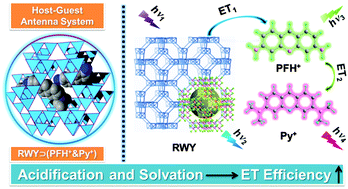Tuning the efficiency of multi-step energy transfer in a host–guest antenna system based on a chalcogenide semiconductor zeolite through acidification and solvation of guests†
Abstract
We report a new multi-step energy transfer process in a host–guest antenna system based on a chalcogenide semiconductor zeolite (coded as RWY). The multi-step vectorial energy transfer assay was fabricated by encapsulating both proflavine ions (PFH+) and pyronine ions (Py+) into the RWY porous framework, serving as a UV-vis light-harvesting host. The ultraviolet high-energy excitation absorbed by the RWY host was channeled to the PFH+ ions and then onto the Py+ ions to give rise to visible-light emission. The steady-state fluorescence and fluorescent dynamics of emission revealed successfully the process of multi-step vectorial energy transfer occurring in the RWY⊃(PFH+&Py+) host–guest antenna system. Moreover, the post treatment of guest ions, such as further acidification of the PFH+ ions and solvation of the guests, was also investigated to tune energy transfer efficiency in such host–guest antenna systems. The current study shows that deep protonation of PFH+ as well as solvation of guest ions can dramatically enhance energy transfer efficiency between the RWY host and PFH+, and even between PFH+ and Py+, much higher than that in an untreated host–guest antenna system.


 Please wait while we load your content...
Please wait while we load your content...